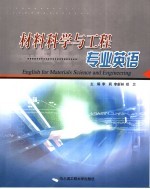

材料科学与工程专业英语PDF电子书下载
- 电子书积分:12 积分如何计算积分?
- 作 者:李莉,李新林,郑卫主编(哈尔滨工程大学材化学院)
- 出 版 社:哈尔滨:哈尔滨工程大学出版社
- 出版年份:2006
- ISBN:7810738941
- 页数:326 页
Part 1 Introduction to Materials Science and Engineering 1
Chapter 1 Introduction 1
1.1 Historical Perspective 1
Catalog 1
1.2 Importance of Materials Science and Engineering 2
1.3 Advanced Materials 3
1.4 Modern Materials Needs 3
Part 2 Physical Foundations of Materials Science 5
Chapter 2 Atomic Structure and Interatomic Bonding 5
2.1 Introduction 5
2.2 Atomic Structure 5
2.3 Electrons in Atoms 6
2.4 The Periodic Table 9
2.5 Atomic Bonding in Solids 11
2.6 Primary Interatomic Bonds 13
3.2 Crystal Structures 20
Chapter 3 The Structure of Crystalline Solids 20
3.1 Introduction 20
3.3 Crystallographic Directions 29
3.4 Crystalline and Noncrystalline Materials 30
Chapter 4 Imperfections in Solids 34
4.1 Introduction 34
4.2 Point Defects 34
4.3 Miscellaneous Imperfection 38
4.4 Grain Size Determination 44
Chapter 5 Diffusion 47
5.1 Introduction 47
5.2 Diffusion Mechanisms 48
5.3 Steady-State Diffusion 50
5.4 Nonsteady-State Diffusion 51
5.5 Factors That Influence Diffusion 53
6.2 Definitions and Basic Concepts 56
Chapter 6 Phase Diagrams 56
6.1 Introduction 56
6.3 Phases 58
6.4 Phase Equilibrium 59
6.5 Equilibrium Phase Diagrams 60
6.6 Interpretation of Phase Diagrams 63
Chapter 7 Phase Transformations in Metals 75
7.1 Introduction 75
7.2 Phase Transformations 76
7.3 Microstructural and Property Changes in Iron-Carbon Alloys 78
7.4 Mechanical Behavior of Iron-Carbon Alloys 89
Part 3 Physical Properties of Materials 94
Chapter 8 Electrical Properties 94
8.1 Introduction 94
8.2 Electrical Conduction 95
8.3 Energy Band Diagrams and Number of Charge Carriers 100
8.4 Classifications of Conductors 103
8.5 Ionic Conduction Mechanisms 108
8.6 Effects of Defects and Impurites 108
8.7 Superconductivity 111
Chapter 9 Thermal Properties 114
9.1 Introduction 114
9.2 Coefficient of Thermal Expansion 114
9.3 Heat Capacity 117
9.4 Thermal Conduction Mechanisms 118
9.5 Thermal Stresses 120
Chapter 10 Magnetic Properties 124
10.1 Introduction 124
10.2 Basic Concepts 125
10.3 Ferromagnetism 126
10.4 Common Magnets 131
11.2 Optical Properties 137
Chapter 11 Optical Properties 137
11.1 Introduction 137
11.3 Interactions of Light with Solids 138
11.4 Atomic and Electronic Interactions 138
11.5 Optical Properties of Metals 140
11.6 Optical Properties of Non-Metals 141
11.7 Applications of Optical Phenomena 145
Part 4 Mechanical Properties of Materials 150
Chapter 12 Mechanical Properties of Metals 150
12.1 Introduction 150
12.2 Concepts of Stress and Strain 151
12.3 Elastic Deformation 155
12.4 Tensile Properties 159
13.1 Introduction 172
13.2 Dislocations and Plastic Deformation 172
Chapter 13 Dislocations and Strengthening Mechanisms 172
13.3 Mechanisms of Strengthening in Metals 180
13.4 Recovery,Recrystallization and Grain Growth 185
Chapter 14 Failure 188
14.1 Introduction 188
14.2 Fracture 188
14.3 Fatigue 203
14.4 Creep 214
Chapter 15 Corrosion and Degradation 219
15.1 Introduction 219
15.2 Nature of Corrosion 220
15.3 Effect Factors of Corrosion 223
15.4 Types of Corrosion 229
15.5 Determination of Corrosion Characteristics 239
15.6 Corrosion control 241
16.2 Annealing Processes 246
16.1 Introduction 246
Chapter 16 Thermal Processing of Metal Alloys 246
Part 5 Processing 246
16.3 Heat Treatment of Steels 250
16.4 Precipitation Hardening 254
Part 6 Materials and Design 260
Chapter 17 Metal Alloys 260
17.1 Introduction 260
17.2 Fabrication of Metals 260
17.3 Ferrous Alloys 266
17.4 Nonferrous Alloys 271
Chapter 18 Ceramics 280
18.1 Introduction 280
18.2 Ceramic Structures 281
18.3 Ceramic Phase Diagrams 284
18.4 Mechanical Properties 285
18.5 Applications of Ceramics 289
Chaper 19 Polymers 297
19.1 Introduction 297
19.2 Polymerization Reactions 298
19.3 Types of Polymers 302
19.4 Strengthening Mechanisms 305
Chapter 20 Composites 311
20.1 Introduction 311
20.2 Classifications of Composites 312
20.3 Particle-Reinforced Composites 313
20.4 Fiber-Reinforced Composites 315
20.5 Structural Composites 317
Chapter 21 Materials Selection and Design Considerations 320
21.1 Introduction 320
21.2 The Property Spectrum 320
21.3 Selection of Materials 322
21.4 Design with Materials 324
- 《看漫画学钢琴 技巧 3》高宁译;(日)川崎美雪 2019
- 《《走近科学》精选丛书 中国UFO悬案调查》郭之文 2019
- 《“十三五”规划教材 中药鉴定学实验 供中药学 药学及相关专业使用 第2版》吴啟南 2018
- 《中医骨伤科学》赵文海,张俐,温建民著 2017
- 《材料导论》张会主编 2019
- 《美国小学分级阅读 二级D 地球科学&物质科学》本书编委会 2016
- 《晚清民国船山学的接受与传播》吴戬著 2019
- 《清代宋词学研究》曹明升著 2019
- 《强磁场下的基础科学问题》中国科学院编 2020
- 《小牛顿科学故事馆 进化论的故事》小牛顿科学教育公司编辑团队 2018
- 《高考快速作文指导》张吉武,鲍志伸主编 2002
- 《建筑施工企业统计》杨淑芝主编 2008
- 《钒产业技术及应用》高峰,彭清静,华骏主编 2019
- 《近代旅游指南汇刊二编 16》王强主编 2017
- 《汉语词汇知识与习得研究》邢红兵主编 2019
- 《黄遵宪集 4》陈铮主编 2019
- 《孙诒让集 1》丁进主编 2016
- 《联吡啶基钌光敏染料的结构与性能的理论研究》李明霞 2019
- 《近代世界史文献丛编 19》王强主编 2017
- 《激光加工实训技能指导理实一体化教程 下》王秀军,徐永红主编;刘波,刘克生副主编 2017
- 《市政工程基础》杨岚编著 2009
- 《大学计算机实验指导及习题解答》曹成志,宋长龙 2019
- 《工程静力学》王科盛主编 2019
- 《中央财政支持提升专业服务产业发展能力项目水利工程专业课程建设成果 设施农业工程技术》赵英编 2018
- 《大学生心理健康与人生发展》王琳责任编辑;(中国)肖宇 2019
- 《大学英语四级考试全真试题 标准模拟 四级》汪开虎主编 2012
- 《大学英语教学的跨文化交际视角研究与创新发展》许丽云,刘枫,尚利明著 2020
- 《化学反应工程》许志美主编 2019
- 《绿色过程工程与清洁生产技术 张懿院士论文集精选 上》《绿色过程工程与清洁生产技术》编写组编 2019
- 《软件工程》齐治昌,谭庆平,宁洪编著 2019
